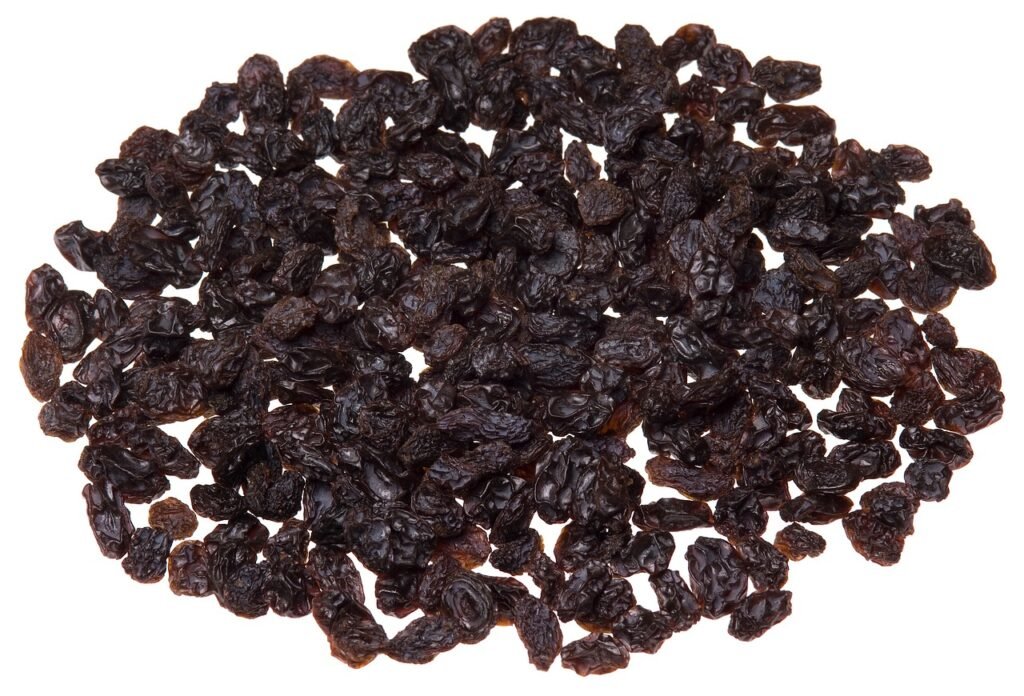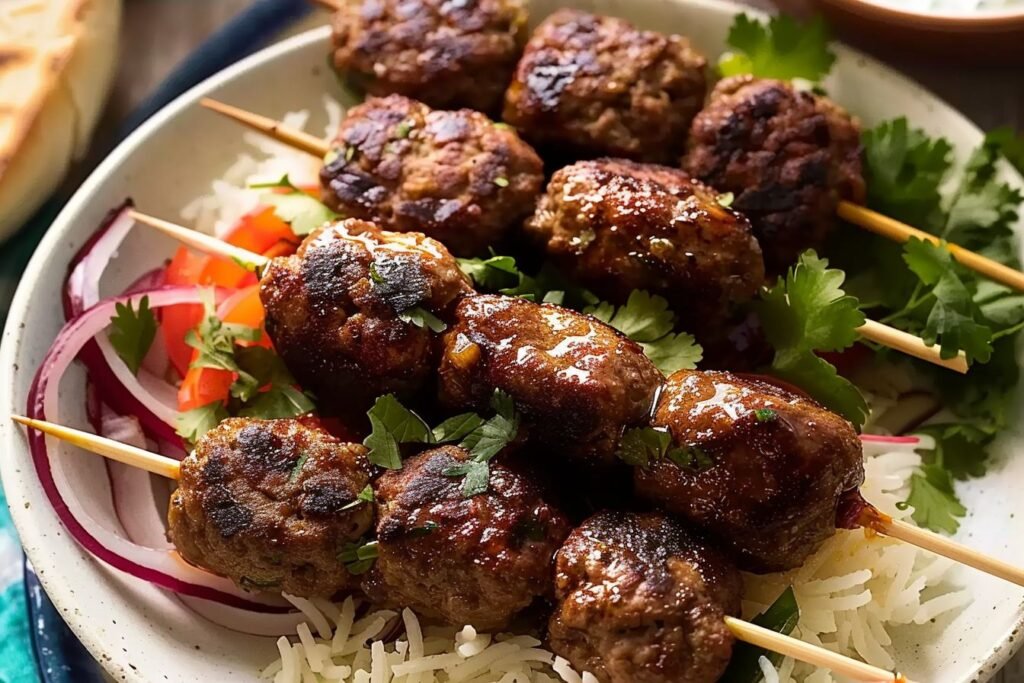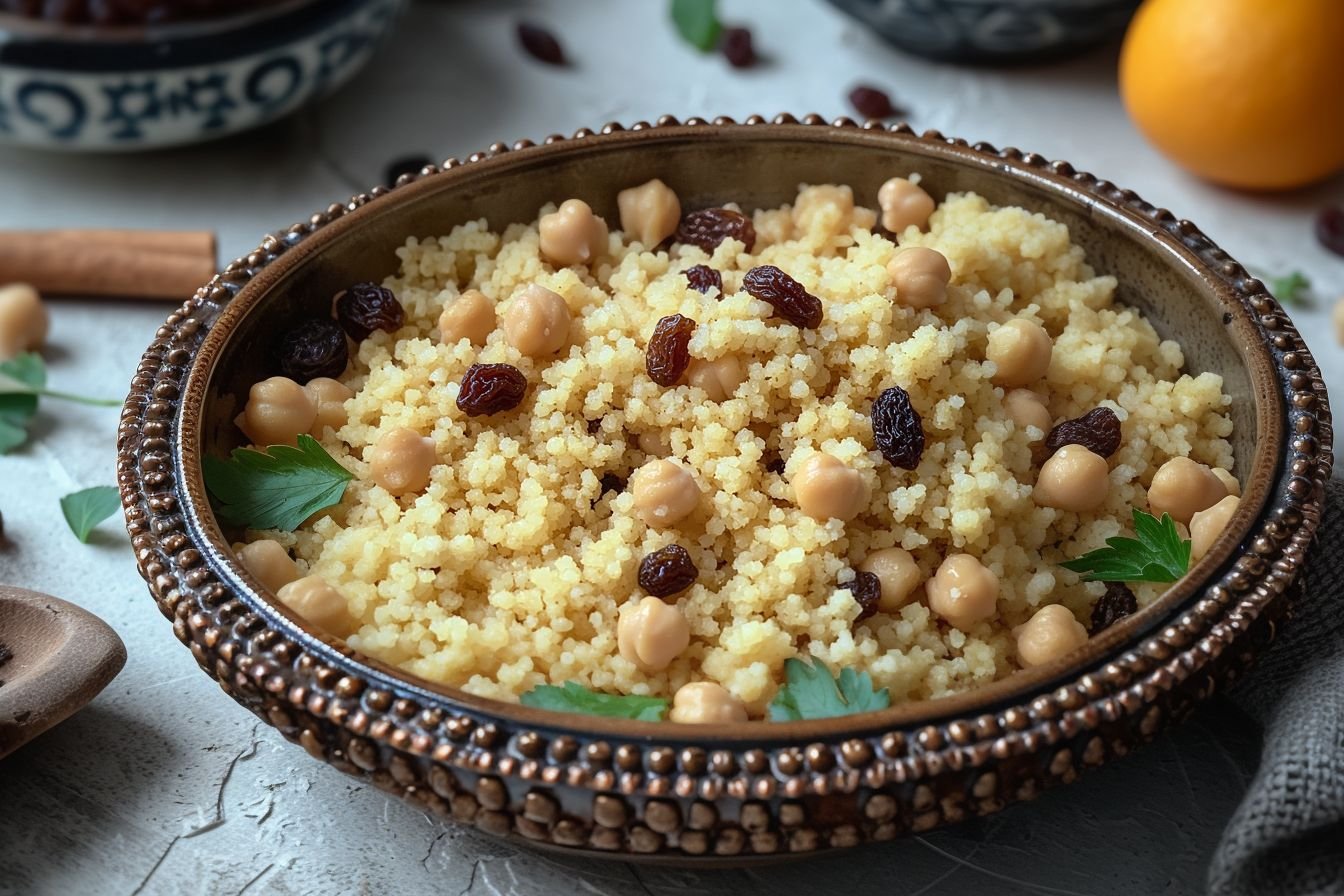Moroccan couscous with raisins is a delightful side dish that combines sweet and savory flavors, making it a standout on any table. This dish features hearty couscous, aromatic spices like cinnamon and turmeric, and the sweetness of dark seedless raisins, all brought together with butter and topped with crunchy toasted pine nuts.
As I prepare this meal, I gather a few simple ingredients: ground cinnamon, turmeric, ground cumin, salt, dark seedless raisins, unsalted butter, couscous, and toasted pine nuts. Each component adds depth and character, transforming a basic grain into an extraordinary culinary experience that transports me to the colorful markets of Morocco.
History of Moroccan Couscous
Moroccan couscous has deep roots, dating back to the 9th century. It originated in North Africa, with the Berber people preparing it first.
This dish uses steamed, granulated wheat, known as semolina. It became a staple for many due to its versatility and nutrition.
Couscous spread throughout the region due to trade and cultural exchanges. It eventually found its way into various cuisines, adapting local flavors along the way.
I find it fascinating that couscous encapsulates not just taste but also history and culture. It serves as a culinary bridge across generations and places.
Today, I like Moroccan couscous not only for its nutty flavor but also for the rich tradition that accompanies it. This dish continues to evolve while staying true to its origins.

Ingredients:
- 1 cup of couscous
- 1 tbsp of unsalted butter
- 1/4 cup of dark seedless raisins
- 1/4 tsp of ground cinnamon
- 1/2 tsp of turmeric
- 1/4 tsp of ground cumin
- 1 tsp of salt
- 1/4 cup of toasted pine nuts
How to make Moroccan couscous with raisins?
- To start, gather your ingredients and grab a 3-quart saucepan. Combine water with spices, raisins, and butter. Bring this mixture to a boil.
- Once boiling, stir in the couscous and remove from heat.
- Toss in some pine nuts and cover the saucepan. Let it sit for about five minutes.
- After the time’s up, fluff the couscous gently with a fork. Finally, transfer it to a serving bowl. Enjoy!
Serving and Presentation
Accompaniments
To complement my Moroccan couscous dish, I often choose a variety of accompaniments, which can elevate the meal. Here are some popular options:
- Vegetable Tagine: A warm, aromatic vegetable tagine paired with spices enhances the couscous’s flavor.
- Harissa: A small dish of this spicy chili paste adds a kick for those who enjoy the heat.
- Yogurt Sauce: Creamy, tangy yogurt can balance the dish, providing a cool contrast to the warm spices.
- Fresh Herbs: I like to sprinkle fresh mint or cilantro over the couscous for an added burst of flavor.
Plating Techniques
Regarding plating, I prefer a few techniques to highlight the dish’s vibrant components. I typically use a shallow bowl or a large platter for an inviting look.
- Creating a Mound: I often form a pyramid of couscous in the center of the plate. This shape naturally draws attention.
- Strategic Garnishing: I like to scatter raisins, almonds, or pine nuts on top for texture and visual appeal.
- Color Contrast: Placing some bright, roasted vegetables around the couscous creates an inviting contrast.
Nutritional Information
Key Nutritional Elements (per serving):
| Nutrient | Amount |
|---|---|
| Calories | 274 kcal |
| Protein | 7g |
| Carbohydrates | 42g |
| Dietary Fiber | 3g |
| Sugars | 6g |
| Fat | 81g |
| Cholesterol | 7.6mg |
Storing and Reheating Leftovers
Storing this dish is simple. I recommend placing leftovers in an airtight container. This helps maintain freshness and prevents any unwanted odors.
Make sure to cool the couscous to room temperature before sealing it. I usually store mine in the refrigerator for up to three days.
If I want to keep it longer, I freeze it. In the freezer, Moroccan couscous can last for about one month. Just remember to label the container with the date.
When it comes to reheating, I prefer using the stovetop for best results. I add a splash of water or broth to keep the couscous moist. Heating on low, I stir it occasionally until it’s warmed through.
Alternatively, I can microwave it. I place the couscous in a microwave-safe dish with a lid. I add a small amount of water, and heat it in 30-second intervals, stirring in between.
Always check the temperature. It should be piping hot before I serve it again.
Common Mistakes to Avoid
- Using the Wrong Type of Couscous: Not all couscous is created equal. I recommend using medium-grain couscous for the best texture.
- Overcooking the Couscous: Couscous cooks quickly. I often find that letting it steam for just 5 minutes is perfect. Too long can make it mushy.
- Skipping the Toasting: Toasting couscous enhances its flavor. I always heat a little oil in the pot and lightly toast the grains before adding water.
- Not Rinsing the Raisins: Sometimes I forget to rinse raisins. This step helps remove any excess sugar and prevents clumping.
- Ignoring Seasoning: Seasoning can transform my dish. I make sure to add salt, spices, and herbs at the right time for full flavor.
- Using Cold Water: Always use hot water or broth. Cold water can shock the couscous and make it steam unevenly.
- Forgetting to Fluff: Fluffing the couscous with a fork after steaming is key. It separates the grains and creates the perfect texture.
Conclusion
Moroccan couscous with raisins offers a delightful blend of flavors and textures. The sweetness of the raisins contrasts beautifully with the savory spices, creating a dish that is both comforting and exciting.
I appreciate how versatile this dish is. It pairs well with various proteins, like chicken, lamb, or vegetables, making it suitable for any occasion.
When I serve this dish, I love to garnish it with fresh herbs. It adds a pop of color and freshness that elevates the presentation.
Ultimately, Moroccan couscous with raisins makes me feel connected to the rich culinary traditions of Morocco. I like preparing and sharing it with family and friends, knowing it brings joy and satisfaction to the table.
One last thing – this dish can be a great side dish for lamb kofta with yogurt sauce!
Interested? Get that recipe now (by clicking the image below):





